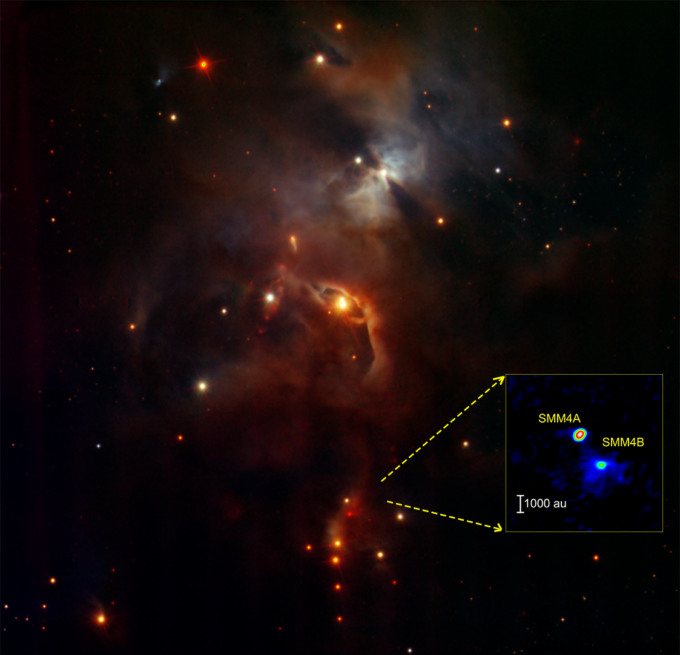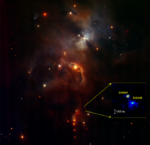Precise Record of Baby-Stars’ Growth on Millimeter Wavelength
Babies grow up fast in the blink of an eye, and thus, their parents wish to record their growth without missing any moment; This is true not only for human babies but also for baby-stars, called protostars, although the recorders are not parents but astronomers in this case. Protostars’ age, or evolutionary stages, has been determined from observations at near and mid-infrared wavelengths. The youngest stage, called Class 0, is defined by non-detection at near and mid-infrared wavelengths, corresponding to <300,000 years old. This definition cannot differentiate younger from older Class 0 protostars. Furthermore, astronomers expect from studies on even older protostars that protostars grow up faster at earlier stages than at later stages, as human babies do, implying that they miss many precious moments of their growth.

The background image shows the Serpens Main star-forming cluster in the near infrared. The inset image shows the location of the two Class 0 protostars SMM4A and SMM4B in the entire group, in 1.3 mm wavelength. Credit: ESO/ALMA(ESO/NAOJ/NRAO)/Aso et al.
As we all know, human “babies” (fetuses) in mothers’ wombs also grow at a fast rate - just as the star babies do. Using ultrasound scanning techniques, parents can hear the baby's heart beating during the regular prenatal examinations; not only so, but they could also even detect how much the thigh bone grows, how much the head circumference is, or perhaps, getting some hints about “girl or boy?”! All of these are essential indicators informing us about how much progress our babies are making concerning growth.
Similarly, to record the critical evolutionary stages of baby stars, rather than ultrasound scanners, astronomers would use millimeter/ sub-millimeter telescopes. To probe the fast growth of Class 0 protostars, an international team led by Dr. Yusuke Aso of Academia Sinica Institute of Astronomy and Astrophysics (ASIAA, Taiwan) has observed three Class 0 protostars using the Atacama Large Millimeter/submillimeter Array (ALMA) and has differentiated evolutionary stages of these protostars in multiple aspects. Thanks to ALMA’s strong capabilities, the team revealed four evolutionary indicators in details: (1) dusty disk growth on 100 astronomical-unit scales, (2) widening of outflow opening angles, (3) carbon monoxide (CO) desorption from icy grains due to temperature rising, and (4) weakening of accretion shock, all of which are consistent with theoretical predictions for young protostars.
Their work demonstrates the importance of millimeter wavelength on probing young protostars’evolution. The work was also accomplished by ALMA’s high spatial resolution differentiating morphology on a small scale and its high sensitivity detecting the faint molecular line from the cold regions. The lead author Dr. Aso says: “From now on, the precious moments of young baby-stars’ fast growth will be recorded more precisely on millimeter wavelength.”
Additional Information
This research was presented in a paper “The Distinct Evolutionary Nature of Two Class 0 Protostars in Serpens Main SMM4” by Aso et al. to appear in the Astrophysical Journal.
The Atacama Large Millimeter/submillimeter Array (ALMA), an international astronomy facility, is a partnership of the European Southern Observatory (ESO), the U.S. National Science Foundation (NSF) and the National Institutes of Natural Sciences (NINS) of Japan in cooperation with the Republic of Chile. ALMA is funded by ESO on behalf of its Member States, by NSF in cooperation with the National Research Council of Canada (NRC) and the Ministry of Science and Technology (MOST) in Taiwan and by NINS in cooperation with the Academia Sinica (AS) in Taiwan and the Korea Astronomy and Space Science Institute (KASI).
ALMA construction and operations are led by ESO on behalf of its Member States; by the National Radio Astronomy Observatory (NRAO), managed by Associated Universities, Inc. (AUI), on behalf of North America; and by the National Astronomical Observatory of Japan (NAOJ) on behalf of East Asia. The Joint ALMA Observatory (JAO) provides the unified leadership and management of the construction, commissioning and operation of ALMA.
Contacts
-
Nicolás Lira
Education and Public Outreach CoordinatorJoint ALMA Observatory, Santiago - ChilePhone: +56 2 2467 6519Cel: +56 9 9445 7726Email: [email protected] -
Masaaki Hiramatsu
Education and Public Outreach Officer, NAOJ Chile -
Charles E. Blue
Public Information OfficerNational Radio Astronomy Observatory Charlottesville, Virginia - USAPhone: +1 434 296 0314Cel: +1 202 236 6324Email: [email protected] -
Calum Turner
ESO Assistant Public Information Officer

